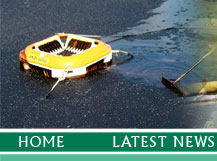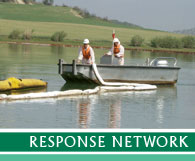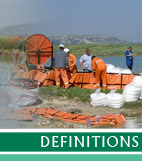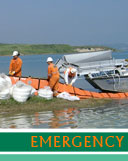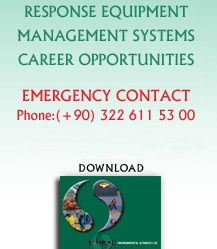29 CFR PART 1910.120 – Chapter
29 of the Code of Federal Regulations, Part 1910.120 is
the Hazardous Waste Operations and Emergency Response reference
document as required by the Superfund Amendment Reauthorization
Act. This document covers employees involved in certain
hazardous waste operations and emergency response to incidents
involving hazardous situations. OSHA enforces this code.
ACCESS CONTROL POINT
– The point of entry and exit from control zones at a Hazardous
Substance Incident. The access control point regulates access
to and from work areas.
AGENCY REPRESENTATIVE –
Individual assigned to an incident from an assisting or
cooperating agency that has been delegated full authority
to make decisions on all matters affecting their agency’s
participation at the incident. Agency Representatives report
to the LO.
AAIR OPERATIONS BRANCH DIRECTOR
– The person primarily responsible for preparing and implementing
the Air Operations portion of the IAP. This individual is
also responsible for providing logistical support to helicopters
operating during the incident.
ALPHA RADIATION – The least
penetrating type of nuclear radiation; not considered dangerous
unless alpha-contaminated particles enter the body.
ADVANCED LIFE SUPPORT (ALS)
– Allowable procedures and techniques utilized by EMT-P
and EMT-II personnel to stabilize critically sick and injured
patient(s) which exceed Basic Life Support procedures.
ALTERNATIVE RESPONSE TECHNOLOGIES
(ART) – Response methods or techniques other than
mechanical containment or recovery. ART may include use
of chemical dispersants, in-situ burning, bioremediation,
or other alternatives. Application of ART must be authorized
and directed by the OSC.
AREA COMMEND – Area Command
is an expansion of the Incident Command function, primarily
designed to manage a very large incident that has multiple
incident management teams assigned. However, an Area Command
can be established anytime when incidents are close enough
that oversight direction is required among incident management
teams to ensure that conflicts do not arise.
ASSIGNED RESOURCES – Resources
checked-in and assigned work tasks on an incident.
ASSIGNMENTS – Tasks given
to resources to perform within a given operational period,
based upon tactical objectives in the IAP.
ASSISTANT – Title for subordinates
of the Command Staff Positions. The title indicates a level
of technical capability, qualifications, and responsibility
subordinate to the primary positions. Assistants may also
be used to supervise Unit activities at Camps.
ASSISTING AGENCY – An agency
directly contributing tactical or service resources to another
agency.
AVAILABLE RESOURCES – Incident-based
resources that are immediately available for assignment.
BASE –
That location at which the primary logistics functions are
coordinated and administered. (Incident name or other designator
will be added to the term “Base.”) The ICP may be collocated
with the Base. There is only one Base per incident.
BETA RADIATION – A type
of nuclear radiation that is more penetrating than alpha
radiation and can damage skin tissue and harm internal organs.
BIOLOGICAL AGENT – Living
organisms, or the materials derived from them, that cause
disease in, or harm to humans, animals, or plants, or cause
deterioration of material. Biological agents may be found
as liquid droplets, aerosols, or dry powders. A biological
agent can be adapted and used as a terrorist weapon, i.e.,
anthrax, tularemia, cholera, encephalitis, plague and botulism.
There are three different types of biological agents: bacteria,
viruses, and toxins.
BIOLOGICAL AGENT – Living
organisms, or the materials derived from them, that cause
disease in, or harm to humans, animals, or plants, or cause
deterioration of material. Biological agents may be found
as liquid droplets, aerosols, or dry powders. A biological
agent can be adapted and used as a terrorist weapon, i.e.,
anthrax, tularemia, cholera, encephalitis, plague and botulism.
There are three different types of biological agents: bacteria,
viruses, and toxins.
BLISTER AGENT A chemical
agent, also called a vesicant, which causes severe blistering
and burns to eyes, skin, and tissues of the respiratory
tract. Exposure is through liquid or vapor contact. Also
referred to as mustard agents; Examples include mustard
and lewisite.
BLOOD AGENT A chemical agent
that interferes with the ability of blood to transport oxygen
and causes asphyxiation. These substances injure a person
by interfering with cell respiration (the exchange of oxygen
and carbon dioxide between blood and tissues). Examples
are hydrogen cyanide and cyanogen chloride.
BLS (Basic Life Support) Basic
non-invasive first-aid procedures and techniques utilized
by EMT-P, EMT-II, EMT-1, EMT-D and FIRST RESPONDER personnel
to stabilize sick and injured patient(s).
B-NICE The acronym for
identifying the five categories of terrorist incidents:
Biological, Nuclear, Incendiary, Chemical, and Explosives.
BRANCH The organizational
level having functional/geographic responsibility for major
incident operations. The Branch level is organizationally
between Section and Division/Group in the Operations Section,
and between Section and Units in the Logistics Section.
CACHE A
pre-determined complement of tools, equipment, and/or supplies
stored in a designated location, and available for incident
use.
CAMP A geographical site,
within the general incident area, (separate from the base),
equipped and staffed to provide sleeping areas, food, water,
and sanitary services to incident personnel.
CHECK-IN Process whereby
resources first report to incident response. Check-in locations
include: Incident Command Post (Resources Unit), Incident
Base, Camps, Staging Areas, Helibases, Helispots, and Division/Group
Supervisors (for direct line assignments).
CEDRE Coopération pour
l'Évaluation et le Développement de la Recherche
CHEMICAL AGENT There are
five classes of chemical agents, all of which produce incapacitation,
serious injury, or death: (1) nerve agents, (2) blister
agents, (3) blood agents, (4) choking agents, and (5) irritating
agents. A chemical substance used in military operations
to kill, seriously injury, or incapacitate people through
its physiological effects.
CHEMICAL ASPHYXIANT Referred
to as blood poisons, these are compounds that interrupt
the flow of oxygen in the blood or the tissues in three
ways: (1) they react more readily than oxygen with the blood.
(Carbon monoxide is the best-known example.) (2) They liberate
the hemoglobin from red blood cells, resulting in a lack
of transport for oxygen. (Hydrazine is one such asphyxiate.)
(3) They cause a malfunction in the oxygen-carrying ability
of the red blood cells. (Benzene and toluene are two examples.)
CHEMTREC Chemical Transportation
Emergency Center is a Public Service of the Chemical Manufacturers
Association. Phone numbers (800)424-9300 and/or (703)527-3887.
CHIEF The ICS title for
individuals responsible for the command of functional Sections:
Operations, Planning, Logistics, and Finance/Administration.
CLC International Convention
on Civil Liability for Oil Pollution Damage
CHOKING AGENT A chemical
agent that causes physical injury to the lungs. In extreme
cases, membranes swell and lungs become filled with liquid,
which can result in asphyxiation resembling drowning. Death
results from lack of oxygen; hence, the victim is “choked”.
Common examples are chlorine and phosgene.
CLEAR TEXT The use of plain
English in radio communications transmission. Neither 10
Codes, nor agency-specific codes are used when using Clear
Text.
COMMAND The act of directing,
ordering, and/or controlling resources by virtue of explicit
legal, agency, or delegated authority. May also refer to
an IC or to the UC.
COMMAND STAFF The Command
Staff consists of the IO, SO, and LO, who report directly
to an IC. They may have an assistant or assistants, as needed.
COMPLEX A complex is two
or more individual incidents located in the same general
proximity, which are assigned to a single IC or UC to facilitate
management.
CONTAMINATION CONTROL LINE (CCL)
The established line around the Contamination
Reduction Zone that separates the Contamination Reduction
Zone from the Support Zone.
CONTAMINATION REDUCTION CORRIDOR
(CRC) That area within the Contamination Reduction
Zone where the actual decontamination is to take place.
Exit from the Exclusion Zone is through the Contamination
Reduction Corridor (CRC). The CRC will become contaminated
as people and equipment pass through to the decontamination
stations.
CONTAMINATION REDUCTION ZONE (CRZ)
That area between the Exclusion Zone and the Support
Zone. This zone contains the Personnel Decontamination Station.
This zone may require a lesser degree of personnel protection
than the Exclusion Zone. This area separates the contaminated
area from the clean area and acts as a buffer to reduce
contamination of the clean area.
CONTROL ZONES The geographical
areas within the control lines set up at a hazardous substance
incident. The three zones most commonly used are the Exclusion
Zone, Contamination Reduction Zone, and Support Zone.
COOPERATING AGENCY An agency
supplying assistance other than direct tactical or support
functions or resources to the incident control effort (e.g.,
Red Cross, law enforcement agency, telephone company, etc.).
COORDINATION CENTER Term
used to describe any facility that is used for the coordination
of agency or jurisdictional resources in support of one
or more incidents.
CORROSIVE MATERIALS One
type of chemical agent that can cause chemical harm at an
incident scene. They are liquids or solids, causing visible
destruction or irreversible alternations in human skin tissue
at the site of contact.
COST SHARING AGREEMENTS
Agreements between agencies or jurisdictions to share designated
costs related to incidents. Cost sharing agreements are
normally written but may also be verbal between an authorized
agency and jurisdictional representatives at the incident.
COST UNIT Functional unit
within the Finance/Administration Section responsible for
tracking costs, analyzing cost data, making cost estimates,
and recommending cost-saving measures.
DEPUTY
A fully qualified individual who, in the absence of a superior,
could be delegated the authority to manage a functional
operation or perform a specific task. In some cases, a Deputy
could act as relief for a superior and, therefore, must
be fully qualified in the position. Deputies can be assigned
to the Incident Commander, General Staff, and Branch Directors.
DIRECTOR ICS title for
individuals responsible for supervision of a Branch.
DISTANCE One of the three
components of the time, distance, and shielding (TDS) response;
refers to the recommendation that one maintain distance
from a hazard, if at all possible. Refer to the Emergency
Response Guide (ERG) as an appropriate resource.
DIVISION That organization
level having responsibility for operation within a defined
geographic area or with functional responsibility. The Division
level is organizationally between the Task Force/Team and
the Branch. (See “Group” also.)
EMERGENCY MEDICAL TECHNICIAN-P
(EMT-P) An individual EMT-1 or EMT-11 who
has received additional training in Advanced Life Support
according to the Health and Safety Code and has a current
and valid county certificate issued pursuant to the health
and Safety Code (formerly called Mobile Intensive Care Paramedics).
EMERGENCY OPERATIONS CENTER (EOC)
A pre-designated facility established by an agency
or jurisdiction to coordinate the overall agency or jurisdictional
response and support to an emergency response.
EMERGENCY SUPPORT FUNCTIONS (ESF)
The Federal Response Plan (FRP) details 12 ESF's
in place to coordinate operations during Federal involvement
in an incident; transportation, communications, public works,
engineering, firefighting, information and planning, mass
care, resource support, health and medical services, urban
search and rescue, hazardous materials, food, and energy.
ETIOLOGICAL HARM One of
six types of harm (see TRACEM) that can be encountered at
a terrorist incident. Involves exposure to a living microorganism,
or its toxins, which causes, or may cause, human disease.
Biological agents are the most obvious examples of etiological
agents.
EXCLUSION ZONE The area
immediately around a spill or release. That area where contamination
does or could occur. The innermost of the three zones of
a hazardous substance/material incident. Special protection
is required for all personnel while in the zone.
EMMSA The Emergency Medicine
Medical Students Association
FEDERAL RESPONSE PLAN (FRP)
Plan developed to help expedite Federal support to disasters.
Generally, the FRP is activated when the State’s resources
are not sufficient to cope with a disaster and the governor
has requested Federal assistance.
FIRST RESPONDER Personnel
who have responsibility to initially respond to emergencies
such as firefighters, law enforcement officers, lifeguards,
forestry personnel, ambulance attendants, and other public
service personnel.
GAMMA RADIATION
Gamma rays are high-energy, ionizing radiation that travel
at the speed of light and have great penetrating power.
They can cause skin burns, severely injury internal organs,
and have long-term physiological effects.
GENERAL STAFF The group
of incident management personnel comprised of: IC, OPS,
PSC, LSC, and Finance/Administration Section Chief.
GEOGRAPHIC INFORMATION SYSTEM (GIS)
An electronic information system, which provides
a geo-referenced database to support management decision-making.
GROUP Groups are established
to divide the incident into functional areas of operation.
Groups are composed of resources assembled to perform a
special function not necessarily within a single geographic
division. (See “Division” also). Groups are located between
Branches (when activated) and Resources in the Operations
Section.
HAZARDOUS SUBSTANCE/MATERIAL
Any substance/material which is explosive, flammable, poisonous,
corrosive, reactive, or radioactive, or any combination,
and requires special care in handling because of the hazards
it poses to public health and welfare, safety, and/or the
environment.
HELIBASE A location within
the general incident area for parking, fueling, maintenance,
and loading of helicopters.
HELISPOT A location where
a helicopter can take off and land. Some helispots may be
used for temporary loading.
HELITANKER A helicopter
equipped with a fixed tanker, Air Tanker Board Certified,
capable of delivering a minimum of 1,100 gallons of water,
retardant, or foam.
HELMEPA Hellenic Marine
Enviroment Protection Association
HNS Hazardous Noxious Substances
HOSPITAL EMERGENCY RESPONSE TEAM
Pre-arranged hospital teams that respond to the
incident upon request.
IMO International
Maritime Organization
ICS International Chamber
of Shipping
INCIDENT ACTION PLAN (IAP)
The IAP, which is initially prepared at the first meeting,
contains general control objectives reflecting the overall
incident strategy (ICS form 201), and specific action plans
for the next operational period. When complete, the Incident
Action Plan will have a number of attachments.
INCIDENT COMMAND POST (ICP)
The location at which the primary command functions are
executed and usually co-located with the Incident Base.
INCIDENT COMMAND SYSTEM (ICS)
A standardized on-scene emergency management concept specifically
designed to allow its user(s) to adopt an integrated organizational
structure equal to the complexity and demands of single
or multiple incidents, without being hindered by jurisdictional
boundaries.
INCIDENT OBJECTIVES Statements
of guidance and direction necessary for the selection of
appropriate strategies, and the tactical direction of resources.
Incident objectives are based on realistic expectations
of what can be accomplished when all allocated resources
have been effectively deployed. Incident objectives must
be achievable and measurable, yet flexible enough to allow
for strategic and tactical alternatives.
INCIDENT SITUATION DISPLAY
The Situation Unit is responsible for maintaining a display
of status boards, which communicate critical incident information
vital to establishing an effective command and control environment.
INITIAL RESPONSE Resources
initially committed to an incident.
INTERTANKO International
Association of Independent Tanker Owners
IOPC The International
Oil Pollution Compensation Funds
IRRITANT AGENT A chemical
agent, also known as riot control agents or tear gas, which
causes respiratory distress and tearing designed to incapacitate.
Common examples include chloropicrin, MACE, tear gas, pepper
spray, and dibenzoxazepine.
ISM International Safety
Management
ITOPF International Tanker
Owners Pollution Federation
JOINT INFORMATION CENTER
(JIC) A facility established within or near
the ICP where the IO and staff can coordinate and provide
information on the incident to the public, media, and other
agencies. The JIC is normally staffed with representation
from the FOSC, SOSC, and RP.
JURISDICTION The range
or sphere of authority. Public agencies have jurisdiction
at an incident related to their legal responsibilities and
authority for incident mitigation. Jurisdictional authority
at an incident can be political/geographical (e.g., city,
county, state or federal boundary lines), or functional
(e.g., police department, health department, etc.). (See
Multi-Jurisdiction incident.)
LEADER The ICS title for
an individual responsible for a Task Force/Strike Team,
or functional unit.
LOGISTICS SECTION
The section responsible for providing facilities, services,
and materials for the incident.
MANAGERS Individuals within
ICS organizational units that are assigned specific managerial
responsibilities (e.g., Staging Area Manager or Camp Manager).
Marpol The International
Convention for the Prevention of Pollution From Ships
MEDICAL TEAM Combinations
of medically trained personnel who are responsible for on-scene
patient treatment.
MESSAGE CENER The Message
Center is part of the Communications Center and collocated
with or adjacent to it. It receives, records, and routes
information about resources reporting to the incident, resource
status, and handles administration, and tactical traffic.
MITGATE Any actions to
contain, reduce, or eliminate the harmful effects of a spill
or release of a hazardous substance/material.
MOBILIZATION CENTER An
off-incident location at which emergency service personnel
and equipment are temporarily located pending assignment,
release, or reassignment.
MORGUE (Temporary On-Incident)
Area designated for temporary placement of the dead. The
Morgue is the responsibility of the Coroner’s Office when
a Coroner’s Representative is on-scene.
MULTI-AGENCY COORDINATION (MAC)
A generalized term which describes the functions and activities
of representatives of involved agencies and/or jurisdictions
who come together to make decisions regarding the prioritizing
of incidents, and the sharing and use of critical resources.
The MAC organization is not a part of the on-scene ICS and
is not involved in developing incident strategy or tactics.
MULTI-AGENCY INCIDENT An
incident where one or more agencies assist a jurisdictional
agency or agencies. May be single or Unified Command.
MULTI-JURISDICTION INCIDENT
An incident requiring action from multiple agencies that
have statutory responsibility for incident mitigation. In
ICS, these incidents will normally be managed using a Unified
Command.
NERVE AGENT
A substance that interferes with the central nervous system.
Exposure is primarily through contact with the liquid (skin
and eyes) and secondarily through inhalation of the vapor.
Three distinct symptoms associated with nerve agents are:
pinpoint pupils, an extreme headache, and severe tightness
in the chest. Examples of nerve agents are: sarin, Soman,
tabun, and VX agent.
NOAA WEATHER STATION A
mobile weather data collection and forecasting facility
(including personnel) provided by the National Oceanic and
Atmospheric Administration, which can be utilized within
the incident area.
OFFICER
The ICS title for personnel responsible for the Command
Staff positions of Safety, Liaison, and Information
OCIMF Oil Companies International
Marine Forum
OPERATIONAL PERIOD The
period of time scheduled for execution of a given set of
operation actions as specified in the IAP. Operational Periods
can be various lengths, usually not over 24 hours. The Operational
Period coincides with the completion of one planning “P”
cycle (see Chapter 3 planning cycle.
OPERATIONS COORDINATION CENTER (OCC)
The primary facility of the Multi-Agency Coordination
System. It houses staff and equipment necessary to perform
MAC functions.
OPERATIONS SECTION This
Section is responsible for all operations directly applicable
to the primary mission. Directs the preparation of Unit
operational plans, requests or releases resources, makes
expedient changes to the IAP as necessary and reports such
to the IC. It includes the Recovery and Protection Branch,
Emergency Response Branch, Air Operations Branch, and Wildlife
Branch.
OPRC International Convention
on Oil Pollution Preparedness
OUT-OF-SERVICE RESOURCES
Resources assigned to an incident, but they are unable to
respond for mechanical, rest, or personnel reasons.
OVERHEAD PERSONNEL Personnel
who are assigned to supervisory positions that includes:
Incident Commander, Command Staff, General Staff, Directors,
Supervisors, and Unit Leaders.
PERSONAL PROTECTIVE
EQUIPMENT (PPE) That equipment and clothing
required to shield or isolate personnel from the chemical,
physical, and biological hazards that may be encountered
at a hazardous substance/material incident. 33 CFR 154.1026,
33 CFR 155.1026.
P&I Protection and Indemnity
Insurance
QUALIFIED INDIVIDUAL
(QI) The person authorized by the responsible
party to act on their behalf, authorize expenditures, and
obligate resources.
RADIATION
There are three types of nuclear radiation: (1) alpha, (2)
beta, and (3) gamma. Radiation is the cause of one of the
six types of harm (see TRACEM) that can be encountered at
a terrorist incident. (Referring to nuclear radiation, not
radiation as a type of heat transfer).
REGIONAL RESPONSE TEAM (RRT)
The Federal response organization, consisting of representatives
from selected Federal and State agencies, which act as a
regional body responsible for planning and preparedness
before an oil spill occurs and for providing advice to the
OSC in the event of a major or substantial spill.
REINFORCED RESPONSE Those
resources requested in addition to the initial response.
REPORTING LOCATION Any
one of six facilities/locations where incident assigned
resources may check-in. The locations are: Incident Command
Post-Resources Unit, Base Camp, Staging Area, Helibase,
or Division/Group Supervisors (for direct line assignments).
Check-in occurs at one location only.
RESOURCES All personnel
and major items of equipment available, or potentially available,
for assignment to incident tasks on which status is maintained.
RESPONDER REHABILITATION
(Also know as “rehab”). Treatment of incident personnel
who are suffering from the effects of strenuous work and/or
extreme conditions.
RESPONSIBLE PRTY (RP) The
owner/operator of the vessel or facility, which is the spill
source.
SAFE REFUGE AREA (SRA)
An area within the Contamination Reduction
Zone for the assemblage of individuals who are witnesses
to the hazardous substance/material incident or were on-site
at the time of the release. This assemblage will provide
for the separation of contaminated persons from non-contaminated
persons.
SECTION That organization
level having functional responsibility for primary segments
or incident operations such as: Operations, Planning, Logistics
and Finance. The Section level is organizationally between
Branch and Incident Commander.
SHIELDING One of the three
components of TDS. Shielding refers to maintaining significant
physical barriers between you and the hazard. Examples include
vehicles, buildings, walls and PPE.
SIMPLE ASPHYXIANT Generally,
an inert gas that displaces the oxygen necessary for breathing,
and dilutes the oxygen concentration below the level that
is useful for the human body.
SINGLE RESOURCE An individual,
a piece of equipment and its personnel complement, or a
crew or team of individuals with an identified work supervisor
that can be used on an incident.
SITE SAFETY AND HEALTH PLAN (SSHP)
Site-specific document required by state and Federal
OSHA regulations and specified in the Area Contingency Plan.
The SSHP, at minimum, addresses, includes, or contains the
following elements: Health and safety hazard analysis for
each site task or operation, comprehensive operations work
plan, personnel training requirements, PPE selection criteria,
site-specific occupational medical monitoring requirements,
air monitoring plan, site control measures, confined space
entry procedures (if needed), pre-entry briefings (tailgate
meetings, initial and as needed), pre-operations commencement
health and safety briefing for all incident participants,
and quality assurance of SSHP effectiveness.
SMS Safety Management System
SOLAS International Convention
for the Safety of Life at Sea
SPAN OF CONTROL A Command
and Control term that means how many organizational elements
may be directly managed by one person. Span of Control may
vary from three to seven, and a ratio of one-to-five reporting
elements is recommended.
STAGING AREA That location
where incident personnel and equipment are assigned awaiting
tactical assignment.
STAKEHOLDERS Any person,
group, or organization affected by and having a vested interest
in the incident and/or the response operation.
STATEMENT OF NO OBLIGATION
The Statement of No Obligation (SNO) is the fundamental
ELT Command and Control mechanism. To ensure that proposed
law enforcement actions are consistent with national and
USCG policy, and, when necessary, to conduct interagency
coordination pursuant to NSC PD-27 requirements (discussed
above), USCG personnel are not authorized to carry out or
take part in certain law enforcement actions prior to receipt
of a Commandant (G-C) SNO from CGHQ. Together, the integrated
SNO and PD-27 processes ensure that all necessary interagency
and international consultations are undertaken prior to
taking law enforcement action.
STRATEGIC GOALS Strategic
goals are broad, general statements of intent.
STRATEGY The general plan
or direction selected to accomplish incident objectives.
STRIKE TEAM Specified combinations
of the same kind and type of resources with common communications
and a leader.
SUPERVISOR ICS title for
individuals responsible for command of a Division or Group.
SUPPORT ZONE In a hazardous
substance response, the clean area outside of the Contamination
Control Line. Equipment and personnel are not expected to
become contaminated in this area. Special protective clothing
is not required. This is the area where resources are assembled
to support the hazardous substances/materials release operation.
TACTICAL DIRECTION
Directions given by the OPS that includes: the tactics appropriate
for the selected strategy, the selection and assignment
of resources, tactics implementation, and performance monitoring
for each operational period.
TACTICS Deploying and directing
resources during an incident to accomplish the objectives
designated by strategy.
TASK FORCE A group of resources
with common communications and a leader assembled for a
specific mission.
TECHNICAL SPECIALISTS Personnel
with special skills who can be used anywhere within the
ICS Organization.
TEMPORARY FLIGHT RESTRICTIONS (TFR)
Temporary airspace restrictions for non-emergency
aircraft in the incident area. TFRs are established by the
Federal Aviation Administration (FAA) to ensure aircraft
safety and are normally limited to a five-nautical-mile
radius and 2000 feet in altitude.
TIME One of the components
of TDS. It refers to the amount of time a responder should
be exposed to an incident. It is recommended that one spend
the shortest amount of time possible in the hazard area.
TURMEPA Turkish Clean Sea
Association
TIME, DISTANCE, AND SHIELDING (TDS)
Three types of protective measures commonly associated
with hazardous materials response.
TOXINS Toxic substances
of natural origin produced by an animal, plant, or microbe.
They differ from chemical substances in that they are not
manmade. Toxins may include botulism, ricin, and mycotoxins.
TRACEM Acronym used to
identify six types of harm one may encounter at a terrorist
incident: Thermal, Radioactive, Asphyxiation, Chemical,
Etiological, and Mechanical.
TRIAGE The screening and
classification of sick, wounded, or injured persons to determine
priority needs in order to ensure the efficient use of medical
personnel, equipment and facilities.
ULCC (Ultra
Large Crude Carrier) Vessel designed for the carriage of
liquid cargo in bulk with a loading capacity over 250.000
DWT.
UNEP United Nations Environment
Programme
UNIFIED COMMAND (UC) A
unified team, that manages an incident by establishing a
common set of incident objectives and strategies. This is
accomplished without loss or abdication of agency or organizational
authority, responsibility or accountability.
UNIT That organizational
element having functional responsibility for a specific
incident planning, logistic, or finance/administration activity.
VESICANTS
Chemical agents; also called blister agents, which cause
severe burns to eyes, skin, and tissues of the respiratory
tract. Also referred to as mustard agents. Examples include
mustard and lewisite.
VIRUS The simplest type
of microorganisms, lacking a system for their own metabolism.
They depend on living cells to multiply and cannot live
long outside of a host. Types of viruses are: smallpox,
Ebola, Mar burg, and Lassa fever.
VLCC (Very Large Crude Carrier)
Vessel designed for the carriage of liquid cargo in bulk
with a loading capacity from 50.000 to 250.000 DWT.
VOLUNTEER Any individual
accepted to perform services by the Lead Agency, which has
the authority to accept volunteer services. A volunteer
is subject to the provisions of the authorizing statute
or regulations.
VTS Vessel Traffic System
WATERSHED REHABILATION
Also know as “rehab”; restoration of watershed
to as-near-as-possible its pre-incident condition, or to
a condition where it can recover on its own.
|
